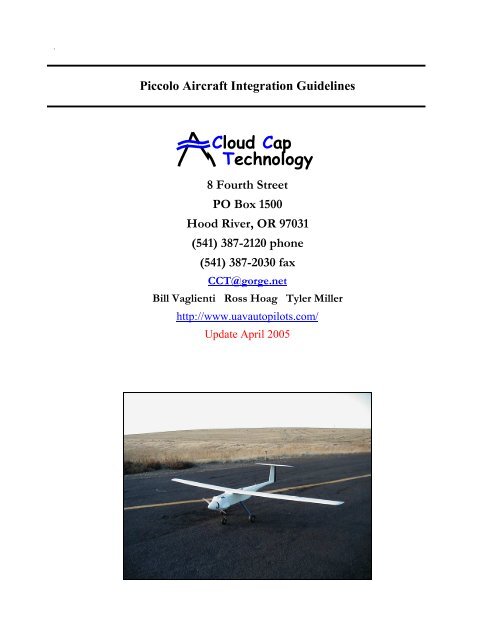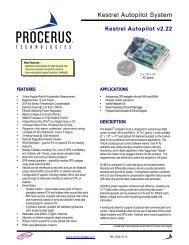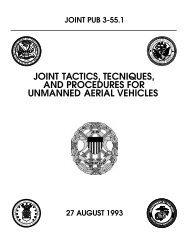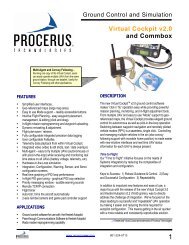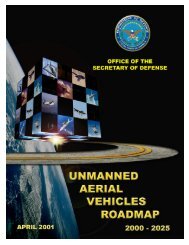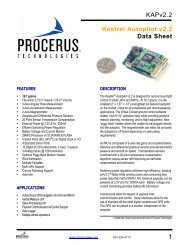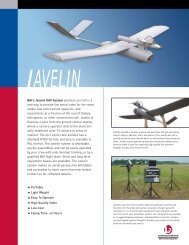Technology Cloud Cap - Unmanned Aircraft & Drones
Technology Cloud Cap - Unmanned Aircraft & Drones
Technology Cloud Cap - Unmanned Aircraft & Drones
You also want an ePaper? Increase the reach of your titles
YUMPU automatically turns print PDFs into web optimized ePapers that Google loves.
Piccolo <strong>Aircraft</strong> Integration Guidelines<strong>Cloud</strong> <strong>Cap</strong><strong>Technology</strong>8 Fourth StreetPO Box 1500Hood River, OR 97031(541) 387-2120 phone(541) 387-2030 faxCCT@gorge.netBill Vaglienti Ross Hoag Tyler Millerhttp://www.uavautopilots.com/Update April 2005
<strong>Cloud</strong> <strong>Cap</strong><strong>Technology</strong>PO Box 1500, No 8 Fourth StreetHood River, OR 97031(541) 387-2120 ph (541) 387-2030faxFigure 1-a – Generic Mount (Horizontal)Figure 1-b – Generic Mount (Vertical)Figure 2 – RnR Piccolo mountFigure 3 – Piccolo unit mounted inside the RnRfuselage (horizontal mount)In either mounting scenario, it is crucial that your Piccolo Autopilot is aligned with theorthogonal axis of your aircraft. A generic alignment procedure is bulleted below.• Pitch Axis - Using a level, align your aircraft with the pitch axis at zero. This isconsidered level flight for your aircraft, typically using the bottom flats of your aircraft’swings as a reference point. Level the top of your Piccolo Autopilot box parallel to thislevel flight orientation.Piccolo <strong>Aircraft</strong> Integration Guidelines Page 4 of 20
<strong>Cloud</strong> <strong>Cap</strong><strong>Technology</strong>PO Box 1500, No 8 Fourth StreetHood River, OR 97031(541) 387-2120 ph (541) 387-2030fax• Roll Axis – Using the level on top of the wings, position your aircraft at level flight withthe roll axis. Now align the Piccolo Autopilot in parallel with this zero degree roll axis(perpendicular to direction of flight).• Yaw Axis – Finding the zero point in the yaw axis is usually the most difficult, unlessyour aircraft has flat sides (parallel to direction of flight) , in which you could turn theaircraft on its side, and define the zero degree yaw using a level. The next best way, is toscribe a line on the center of your mount or the Piccolo Autopilot, parallel to the sides ofthe Piccolo Autopilot box. Align it with the center of your aircraft in the direction offlight, by taking measurement off the insides of your aircraft’s fuselage. If your PiccoloAutopilot is visible through a hatch, always check your placement by standing behind theaircraft’s tail, and visually seeing the scribed line with the alignment of your aircraft.There are multiple ways to engineer a proper mount, and no single method is best for allapplications. Outlined above are two relatively simple methods which meet the generalrequirements, and should help guide you in your Piccoloinstallation.If soft mounting the avionics is not viable, or you arecarrying other vibration sensitive payloads, such as avideo camera with zoom, a third option to consider, isdampening the vibration at its source with soft enginemounts. Figure 4 displays engine vibration dampeningmounts. Many existing platforms use a combination ofengine and avionics soft mounts to solve this problem.Figure 4 – Vibration Dampening MountsAfter the completion of your Piccolo installation, you should install your Piccolo, power it up,collect some baseline telemetry with the engine off, then again with the engine on (see section7.2.2). A comparison of the two data sets will give you a good idea of how well your mount isperforming. The single most important thing you can do to increase your chances of successfulautonomous flight, which I will mention again and again throughout this text, is to test and retesteverything on the ground before you attempt to fly.3 Antenna IntegrationThere are two antennas that must be installed on your airframe; the first is the COMM antennaused for line of sight communications between your Piccolo and its Ground Station; the secondis the all-important GPS antenna used for position and velocity determination. The GPS isreceive only, while the COMM is both receive and transmit (typically Piccolo’s are configuredfor 1-watt transmit power). Small airplanes present big problems when it comes to RFPiccolo <strong>Aircraft</strong> Integration Guidelines Page 5 of 20
<strong>Cloud</strong> <strong>Cap</strong><strong>Technology</strong>PO Box 1500, No 8 Fourth StreetHood River, OR 97031(541) 387-2120 ph (541) 387-2030faxinterference so every effort should be made to minimize the potential problems from the start.While every installation is unique, there are two primary objectives when considering initialantenna placements.1. You should try to maximize antenna separation. Mount the antennas as far apart fromeach other, or any other antennas, as physically possible.2. Find a convenient spot on the top surface of the airframe or wing with an unobstructedview of the sky for the GPS antenna.If you can, try to locate both antennas on the fuselage (not on the wing), as shown in Fig. 5below. This offers the best configuration for testing both the GPS and COMM installationswithout the wing installed, which is much easier in the lab as well as in the field. It also meansyou don’t have to connect/disconnect the two RF connectors each time you install and removethe wing. This eliminates a potential failure mode and makes the assembly/disassembly mucheasier (especially if the wind is blowing and your Piccolo is tucked in a tight spot in thefuselage).3.1 GPSThe MK-4 GPS antenna supplied with the Piccolo is a 3-5 volt active patch that requiresmounting on a small ground plane. Any 3-volt active or passive patch should work, but makesure you test it thoroughly against the MK-4 supplied with your Piccolo. While the suppliedantenna will work without a ground plane, performance will not be optimal. Remember, theGPS is the single most important sensor and thus care should be taken to ensure maximumperformance at all flight attitudes. Adding even a small ground plane (a few inches larger thanthe antenna) will enhance the GPS performance substantially. Your ground plane can be put onthe inside or outside of the mounting surface, just make sure the antenna is securely mounted toit (both mechanically and electrically). Figure 5 displays the ground plane configurations forboth antennas on our RnR trainer; the shaded areas display the location of the ground planesmounted inside the fuselage.Piccolo <strong>Aircraft</strong> Integration Guidelines Page 6 of 20
<strong>Cloud</strong> <strong>Cap</strong><strong>Technology</strong>PO Box 1500, No 8 Fourth StreetHood River, OR 97031(541) 387-2120 ph (541) 387-2030faxFigure 5 – GPS Antenna and 902-928 MHz ground planes (shaded)The other concern is RF shading, if you decide to mount the antenna inside the fuselage or wing,you must be sure the top surface of the antenna (its radome) is not touching anything and thatwhatever is covering it, does not attenuate the incoming GPS signals. If you place the antenna ina wing near a carbon spar or servo leads, its performance will suffer. The antenna has two smalltapped holes for hard mounting; it’s highly recommended that they be used (don’t forget to useloctite). Notice in Fig. 6, the unobstructed view of the GPS located on our trainer airplane. Theplacement provides good performance, while offering reasonable separation from the engine andthe aft mounted COMM antenna.Piccolo <strong>Aircraft</strong> Integration Guidelines Page 7 of 20
<strong>Cloud</strong> <strong>Cap</strong><strong>Technology</strong>PO Box 1500, No 8 Fourth StreetHood River, OR 97031(541) 387-2120 ph (541) 387-2030faxFigure 6 –GPS & 900 MHz Antenna LocationWhen you test your installation, do it at all flight attitudes, if your GPS performance is not rocksolid at every flight attitude, you more than likely have a problem with interference or badantenna placement.3.2 COMMThe multitude of options for COMM antennas and the theory behind each is beyond the scope ofthis document. Our intent here is to outline one possible solution that meets the requirement forlocal line of sight flight operations for test and evaluation purposes only. Piccolo productoptions support communications link implementations in many frequency ranges, but mostcommonly in either the 902-928 MHz ISM unlicensed band, or the 2.4 GHz ISM unlicensedband.The requirements for our simple antenna are as follows:• It must be easy to fabricate and install.• No matching network or balun design required (choose a design whose feed pointimpedance is close to 50 ohms).• It should have an omni directional radiation pattern.• The gain should be close to unity.• Needs to be vertically mounted on the aircraft.The ¼ wave dipole or ground plane antenna meets all of these requirements and generally youcan get it working without any tuning. This type of antenna does require a ¼ wavelengthground plane.• For 902-928 MHz band radios, (at center band frequency of 912 MHz) the radius of acircular ground plane is 8.22 cm (3.24”).• For 2.4 GHz band radios, the radius of a circular ground plane is 3.12 cm (1.23”).Piccolo <strong>Aircraft</strong> Integration Guidelines Page 8 of 20
<strong>Cloud</strong> <strong>Cap</strong><strong>Technology</strong>PO Box 1500, No 8 Fourth StreetHood River, OR 97031(541) 387-2120 ph (541) 387-2030faxThe ¼ wave radiating element is placed in the center of the ground plane with the radiatingelement hooked to the feed line (center conductor of the coax) while the ground plane is hookedto the coax shield, see Fig 7.1/4 wave radiatorFeed line (coax)feed pointFigure 7 - Antenna Schematic1/4 wave radius ground planeIt turns out that this type of antenna has a feed point impedance of about 52 ohms which matchesnicely with standard 50 ohm coax. This allows you to hook your feed line directly to the antennawithout any matching network or balun. Even if the geometry is not perfect, which translates toan impedance mismatch, you should get reasonable performance. To build this type of antennathe antenna itself can be made from a ¼ wave radiating element cut to the proper frequency, oruse purchased antenna elements as provided in the Piccolo Kit.A good way to make the ground plane is to use conductive foil or thin sheeting cut to size andbonded to an aircraft surface. The ground plane can be placed on the inside or outside of thefuselage or wing, as the particulars of the airframe require. You do have to make sure that thecoaxial antenna feed ground has a good electrical connection to the ground plane: with theprovided antennas, this electrical connection for the 902-928 MHz band is at the top surface(antenna side) of the ground plane, and for the 2.4 GHz antenna, this electrical connection is atthe bottom surface of the ground plane.As stated above, location of the antenna on the aircraft is important to optimize COMM linkmargin. Things to consider during antenna location selection include:• Try to find a location on the fuselage. This facilitates testing in the lab without wingsattached and eliminates the concern for RF connections when removing the wings.• Pattern gain of the ¼ wave stub antenna is higher on the antenna side of the ground plane.It may be that the best antenna performance will be with the antenna on the bottom of theaircraft. In tests with our trainer, 2.4 GHz link performance was up to 15 dB better withthe antenna mounted on the bottom vs. the top of the fuselage.• Keep COMM and other aircraft antennas separated to the extent possible to reduce signalinterference to a minimum.• Be aware of blockage by other elements of the aircraft. For example, landing gear maybe an issue for mounting on the bottom, and engine components may be a RF blockingsource when antenna is mounted on the top.Antenna location will always be an exercise in finding the best fit among criteria.Piccolo <strong>Aircraft</strong> Integration Guidelines Page 9 of 20
<strong>Cloud</strong> <strong>Cap</strong><strong>Technology</strong>PO Box 1500, No 8 Fourth StreetHood River, OR 97031(541) 387-2120 ph (541) 387-2030fax902-928 MHz COMM Link Option¼ wave Antenna - BNC mount,Radial/Larsen # KD14freq(912) BNCmount cut to 912MHzCOMM Antenna Cable – “BNC FemaleBulkhead to SMA male plug” See CCTweb pages for reference schematic andordering info.Ground Plane – Circular ground planeradius is 3.24 inches. Electricalconnection to feed ground is on the topside of the ground plane.2.4 GHz COMM Link Option¼ wave Antenna - Maxrad #MSSO2300-XXX (24” cable) orMSSO2300-YYY (48” cable) .COMM Antenna Cable – Integral toantenna. Has SMA male plug forconnection to avionics.Ground Plane – Circular ground planeradius is 1.23 inches. Electricalconnection to feed ground is on thebottom side of the ground plane.Figure 6 shows our trainer aircraft with the 902-928 MHz COMM antenna installation. Theground plane is mounted on the inside of the fuselage (shaded are in Fig 5). Note this is not theantenna you would want on any production airplane, it adds drag, BNC connectors are notweatherproof, it weighs more than it needs to, and it’s not going to provide maximumrange/sensitivity as compared to a properly engineered one.Figure 8 displays the 2.4 GHz COMM antenna mounted on the bottom of our trainer aircraft,noting the ground plane is installed inside the fuselage. This antenna is quite small, and is out ofthe way when mounted on the bottom of our aircraft.Piccolo <strong>Aircraft</strong> Integration Guidelines Page 10 of 20
<strong>Cloud</strong> <strong>Cap</strong><strong>Technology</strong>PO Box 1500, No 8 Fourth StreetHood River, OR 97031(541) 387-2120 ph (541) 387-2030faxIf you have access to a network analyzer or signalsource and a SWR meter you can check the matchand fine-tune your antenna system for maximumperformance. Again, the best way to verifyperformance is to test it. More on the testing partlater.4 Air Data SystemsPiccolo has pressure port inputs for total (or pitot)pressure and static pressure. A 4KPa differentialpressure sensor measures the difference between thetotal pressure and static pressure to determine thedynamic pressure. A 115KPa absolute pressuresensor measures the static pressure. An accurate airdata system is critical to the performance of Piccolo.Both the dynamic and static pressures are used in theprimary control loops. In addition the dynamicpressure is used to calculate the true air speed, whichis used for wind measurement.Figure 8 – 2.4 GHz COMM antenna (bottom)4.1 Pitot SystemThe pitot reference is created by facing a simple tube into the airflow. The primary requirementsare that the tube should face the prevailing wind for all possible pitch and yaw attitudes. As anexample, consider the installation of the pitot tube on our trainer vehicle shown in Fig. 9.Figure 9 –Pitot tube mountThis simple pitot tube is made with soft aluminum tubing bent for optimal exposure throughoutflight. The location on the bottom of the wing places the pitot tube out of the way of thepropeller wake, and keeps the prevailing flow facing the tube even for a wide range of pitchattitudes. Inside the wing the aluminum tubing is fastened to soft Tygon tubing, which runsthrough the fuselage back to the Piccolo avionics. Virtually any installation position will workas long as you satisfy these basic requirements:• The pitot tube must face into the airflow.Piccolo <strong>Aircraft</strong> Integration Guidelines Page 11 of 20
<strong>Cloud</strong> <strong>Cap</strong><strong>Technology</strong>PO Box 1500, No 8 Fourth StreetHood River, OR 97031(541) 387-2120 ph (541) 387-2030fax• The pitot tube must not be in the propeller wake (a thrusting propeller adds total pressureto the flow and will corrupt the reading).• There should be no leaks or obstructions in the path between the pitot port inlet and thesensor in the avionics.The last point brings up an interesting question: what about flying in the rain? The pitot tubeshown in Fig. 9 is suitable for flying in the rain, due to the large opening (1/4 in.) which preventsthe bridging of a drop of water. If a water droplet bridges the pathways of the Pitot tube, it wouldobstruct the total pressure path. For slow speed vehicles the pitot tube needs be on the order of¼” in diameter to prevent water droplets from bridging across it.4.2 Static SystemAn accurate static pressure system is more complicated than the pitot system. Many small UAVsdo not include a static pressure reference, instead using the internal fuselage pressure as the staticpressure. This is a bad idea because the fuselage is not typically vented in any consistent wayand may host pressures which are far from static.Typically full size aircraft go through a test and evaluation period in which a position on thefuselage exterior is found that is close to static pressure, and that is used for the static source.Until such an evaluation can be done we recommend that you use a static reference similar toFig. 10.Figure 10 – Example static tube on the right wingtipOur location of the Static tube on the wing was based on a location that; wouldn’t be influencedby the fuselage pressure disturbance, and far enough in from the wingtip to prevent damageduring take off or landing if the wing tip touched the ground. The static system shown in Fig. 10is made of a ¼” carbon tubing. The end of the tube is plugged and rounded off to minimize thedisturbance to the air flowing over the tube. Back from the tip, at least 8 tube diameters, a ringof four small holes are drilled symmetrically around the shaft. The holes are the static pressuresource. In the wing the back side of the shaft is sealed and connected to soft Tygon tubing whichruns back to the static port on the avionics. Some things to watch out for when using this type ofstatic source:• A squared off or rough tip will cause disturbances that will affect the static pressure.This can be mitigated by moving the static pressure holes further back along the tube.Piccolo <strong>Aircraft</strong> Integration Guidelines Page 12 of 20
<strong>Cloud</strong> <strong>Cap</strong><strong>Technology</strong>PO Box 1500, No 8 Fourth StreetHood River, OR 97031(541) 387-2120 ph (541) 387-2030fax• The mount structure behind the tube can influence the static pressure field (assuming thevehicle is subsonic!). If the structure is large (like a fat fuselage) the effect can besignificant. While the exact effect is difficult to predict without some form ofcomputational fluid dynamics; a rough rule of thumb is that the static pressure holesshould be in front of the structure a distance of twice the structure diameter (assuming ablunt axisymmetric structure like a UAV fuselage).5 Wiring HarnessYou will need to build, or purchase from us, a flight harness that supports your aircraft servoconfiguration. If you decide to build your own flight harnesses follow these guidelines:• Make all leads as short as possible (minimize extra wire length); this will help with RFcoupling from onboard transmitter which can interfere with RC hobby servos.• Avoid using servo lead extensions, the extra wire and extra connectors all will addpotential failure mode.• When routing your servo and RF leads try to keep them separated as much as possible,cleanly routed and tied down. Never run coax in parallel with unshielded servo wires. Ifyou have to troubleshoot RF interference problems working with a neat and cleaninstallation will make your job much easier. If you are working with a rat’s nest of wiresand connectors with extra leads everywhere the likelihood of success in troubleshooting,and the repeatability from vehicle to vehicle, will be limited.• Use crimp pin and socket connectors, do not use solder cup type connectors. Solderjoints on wiring harnesses will fail due to vibration unless proper strain relief is provided.5.1 Typical Flight HarnessBelow is the schematic for a typical flight harness with ailerons, for a printable version go to thedownload page on our website (www.uavautopilots.com). We also stock these as shown if youdon’t want to assemble them yourself.Piccolo <strong>Aircraft</strong> Integration Guidelines Page 13 of 20
<strong>Cloud</strong> <strong>Cap</strong><strong>Technology</strong>PO Box 1500, No 8 Fourth StreetHood River, OR 97031(541) 387-2120 ph (541) 387-2030fax6.3 Deadman’s PowerThe deadman’s switch consists of a power MOSFET driven by a watchdog timer circuit. Undernormal operation the timer circuit is refreshed by software and the deadman switch remains on.If the system fails, either due to software or hardware failure, the deadman’s switch turns off.This switch can be connected to an ignition system, or some other flight termination system, andso provide a measure of safety in the event that the system fails. The deadman switch is poweredby the servo input power and can supply up to 1 Amp.7 Integration Testing7.1 In the Lab7.1.1 Orientation Configuration and TestIt is crucial in the autopilot performance that the Piccolo Avionics orthogonal axis are alignedwith that of the aircraft’s in the final installation. The avionics has a reference coordinatesystem, which is marked on the front panel. The coordinate system uses English aircraftconventions, with the X-axis pointing through the nose, the Y-axis out the right wing tip, and theZ-axis pointing down. You do not have to install the avionics in its natural coordinate system;however the Euler angle rotations between the avionics coordinate system and the aircraftcoordinate system must be known.The installation orientation is given by the three Euler angles: Yaw (psi), Pitch (theta), and Roll(phi). Currently the operator interface only supports choosing Euler angles that are alongprincipal axes of the vehicle. There are 24 different possible principal axis orientations. Theangles describe the rotation from the avionics coordinate frame to the vehicle coordinate frame.When applying the angles, the default is the order given above: first the coordinate system isrotated about the Z-axis (psi), then the coordinate system is rotated about the new Y-axis (theta),and finally the coordinate system is rotated about the new X-axis (phi). It is difficult to visualizethe entire process, however you can use the display on the sensors page of the operator interfaceto help you. The most important thing you can do is test the result.To verify correct orientation rotate the aircraft nose right and nose left; the yaw rate sensorshould indicate positive and negative values respectively. Rotate the aircraft nose up and nosedown; the pitch rate sensor should indicate positive and negative values respectively. Finallyrotate the aircraft roll right and roll left; the roll rate sensor should indicate positive and negativevalues respectively.7.1.2 Control Surface CalibrationsOn a small aircraft, the linkage between the servo actuator and the control surface is often nonlinear.In order to account for the sense of the rotation, and for the non-linearities, the surfacesmust be calibrated. The calibration is basically the relationship between the pulse width sent tothe actuator and the surface deflection that results. In the case of the throttle the surfacedeflection is interpreted as percent of full scale, and is always between 0.0 and 1.0. Foraerodynamic control surfaces the deflection is measured as an angle and has the following signconvention: flaps, ailerons, and elevators are all positive down. Rudders are positive right. Forruddervators the sign convention follows the elevator rule, i.e. positive down.Piccolo <strong>Aircraft</strong> Integration Guidelines Page 15 of 20
<strong>Cloud</strong> <strong>Cap</strong><strong>Technology</strong>PO Box 1500, No 8 Fourth StreetHood River, OR 97031(541) 387-2120 ph (541) 387-2030faxThe piccolo software gives the user the ability to send a specific pulse width from a specificchannel. You can use this feature to help you calibrate the control surface. See the “PiccoloUser’s Guide” for instructions on using the surface test feature. The process is as follows: usethe software to send a specific pulse width to a specific channel. Measure the resulting surfacedeflection (be sure to follow the sign convention above), and enter the results in the calibrationtable on the operator interface. Then repeat the process for ten points. When you have thecalibration complete you send the data to the avionics. The limits of the surface calibration tabledefine the absolute limits of the pulse width that Piccolo will send to the control. A typicalcalibration table will run from 1103 to 1929 microseconds; this is full scale as represented by atypical Futaba pilot console. There is no requirement that points of the table be spaced evenly,but they must be monotonic, i.e. always increasing or always decreasing.Once you’ve done all this work you should save the results by using the Save button on theoperator interface surfaces page. This will write the calibration table out to a file. You canreload the settings from this file later if you change the avionics that is installed in the vehicle.You can test the results by moving the control surfaces under manual control and comparing thereported control surface positions (displayed on the autopilot gains page) with the actual surfacepositions.7.1.3 Setting up the pilot consoleAlthough Piccolo supports ten different control outputs the autopilot only understands fivedifferent control axis (Roll, Pitch, Thrust, Yaw, and Flaps); and outputs five different commandsignals (Aileron, Elevator, Throttle, Rudder, and Flaps). Mixing rules outside of the autopilotare used to create ten outputs from the five commands. See the “Piccolo User’s Guide” fordetails on how this is done. The important thing you should understand here is that when undermanual control only the five signals (plus channel 5, autopilot on/off) are sampled. The fivemanual control signals are passed through the exact same mixing rules to generate the outputs.Hence your pilot console should not include any mixing which conflicts with the mixing rules onPiccolo: multiple servos for a single control axis, flaperons, elevons, or V-tail. If your vehiclerequires these features then the mixing should be setup on Piccolo, and not on the pilot console.The pilot console can be used to control the direction and sensitivity under manual control soservo reversing, dual rate, ATV, and exponential can be used to get the vehicle “feel” to be whatyou need.7.1.4 Under simulationThe simulator is the basic tool used to train operators and to validate the settings given toPiccolo. We cannot place enough emphasis on this: You MUST successfully simulate beforeflying. Beware the hobbyist mentality that tries to skip steps and go straight to flight test.The “Piccolo Quick Setup Guide” gives instructions on how to setup and run the simulator. Afactory default Piccolo unit is setup for our flight test vehicle, and a suitable model has beenprovided with the rest of the software. If you follow the quick setup guide you should see thesystem operating correctly.Your task now is to create a dynamics model for your specific vehicle. Start with the cub modelthat was provided and modify the parameters as required. A description of each parameter canbe found in the “Piccolo Simulator” document. Once your model is complete, you can validate itby “flying” the Piccolo under manual control.Piccolo <strong>Aircraft</strong> Integration Guidelines Page 16 of 20
<strong>Cloud</strong> <strong>Cap</strong><strong>Technology</strong>PO Box 1500, No 8 Fourth StreetHood River, OR 97031(541) 387-2120 ph (541) 387-2030fax7.1.5 Adjusting gainsIf the vehicle is similar to the Cub trainer plane (default model shipped with your simulationsystem), then the default gains in your Piccolo may suffice. If you happen to be so lucky youcan just enable the autopilot and fine tune the gains as needed. Many vehicles however aresufficiently different that you must start from scratch in developing gains. There is no magicformula for determining the gains, it is mostly a process of trial and error. Follow the steps givenin the document “Initial Flight Test Cards” to develop gains for a new vehicle.7.2 In the fieldAt this point you should have integrated your avionics into the airframe, calibrated the controlsurfaces, developed a model of your aircraft for the simulator, and derived a set of autopilotgains while flying in the hardware in loop simulator. If you have not successfully completed theabove steps you are NOT ready to proceed. The next step is to go out to the field and do acomplete systems check.For all of the following testing you will want to setup as if you were going flying. You needyour ground station setup and configured as you expect it to be when you fly, as well as yourvehicle assembled and ready to power up. This implies antennas installed on a proper groundplane, the pilot console hooked up, and whatever power source you will use up and running aswell as the operator interface running on a laptop computer. We typically use a van as our flightoperations vehicle since it provides a convenient and mobile operations platform as well as offersa ready-made ground plane for mounting the GPS and COMM antennas.After setup, you should work your way through the following preflight checklist. This list isintegrated into the operator interface. You should ALWAYS run through this before taking off:it will save you from most of the common and costly mistakes.Piccolo <strong>Aircraft</strong> Integration Guidelines Page 17 of 20
<strong>Cloud</strong> <strong>Cap</strong><strong>Technology</strong>PO Box 1500, No 8 Fourth StreetHood River, OR 97031(541) 387-2120 ph (541) 387-2030faxPreflight checklist for the Piccolo system1. Turn on Piccolo and Ground Station, and launch the Operator Interface application.2. Verify and/or configure the ground station address list and pilot address.3. Verify working communications.4. Verify working aircraft GPS, check number of satellites and PDOP.5. Check and record initial battery voltage and current (typically 300mA at 12V).6. Configure map page as required by the mission.7. Configure flight plans as required by the mission, including lost comm flight plan.8. Verify correct autopilot gains, limits and trim settings (if known. i ).9. Verify correct mission limits including deadman status and lost comm waypoint.10. Set altimeter to local base pressure if known. ii11. Select manual control and verify manual control displayed in autopilot page.12. Verify control surface trims in manual mode. Adjust as necessary using the pilot console.13. Verify manual control, both magnitude and direction, for all control surfaces.14. Verify the reported control surfaces on the preflight page match the actual control positions.15. Check sensor readings and zero them if needed. iii16. Check the correct operation of the gyros and accelerometers by physically rotating theaircraft and verifying the sensor outputs iv .17. Verify that the pitot tube is clear by blowing into it and seeing the airspeed response.18. Configure the autopilot loops as needed, typically all loops on, with the waypoint setaccording to the overhead flight plan. Select manual control from the pilot console.19. Start the engine and verify correct operation through the entire RPM range. Check sensorreadings for signs of excessive noise due to engine vibration at different RPMs.20. Check communications at the far end of the runway strip. RSSI signal should indicate closeto the maximum reading (-71 dBm) v .21. Check for aircraft traffic and make any radio calls mandated by air traffic control.22. Determine the takeoff direction and set the initial waypoint in the event of lost comm.23. Final check on the system: Battery voltage and current, GPS health, RSSI, and sensors.24. Takeoff and start watch or timer.Piccolo <strong>Aircraft</strong> Integration Guidelines Page 18 of 20
<strong>Cloud</strong> <strong>Cap</strong><strong>Technology</strong>PO Box 1500, No 8 Fourth StreetHood River, OR 97031(541) 387-2120 ph (541) 387-2030fax7.2.1 Controls CheckThe first test is to verify your control surface configuration and calibration. Once you power upthe aircraft and see telemetry you can take manual control, check the trims and walk through acomplete controls check including throttle. Once this is done and you are happy with thedirection and range of throw check for any abnormal servo chatter or motion caused by theonboard transmitter. If you do detect any periodic movement turn off the ground station power,if the chatter disappears you likely are experiencing interference from the onboard 1-watttransmitter (Piccolo will not transmit if the ground station isn’t running). Make any necessaryadjustments to your servo wire routing to correct the interference before proceeding.7.2.2 Engine On Vibration TestingOnce positive control has been achieved you can start the engine and verify proper operation.The first step is to turn on fast telemetry, this will display and log 20Hz data which allows youto better analyze the state of the sensors. Next slowly run the engine through its full RPM rangeat the same time watching the sensor data on the telemetry page. You should be watching boththe rate output of the gyros as well as the attitude estimation displayed above it. If you don’t seeany large excursions (above single digit readings for the rates) and your attitude estimationis stable (less than a few degree of drift over the entire operational rpm range) then yourmount should be suitable. If you do see large rates and/or the attitude estimation diverges at aparticular rpm (you find an airframe/mount resonance point) you must correct it before youattempt to fly. If you have questions as to what is good or bad feel free to give us a call directly.We can analyze your telemetry data by either replaying the .tel file or by plotting the datadirectly from the .log file.The next step with the engine running is to set the throttle limits. The manual piloting limits areset by the control surface calibrations. This provides the pilot full authority over the of the entirethrottle range, i.e the pilot should be able to close the throttle and kill the engine. This isobviously not acceptable for autopilot operation so you need to set the min and max throttlesettings on the limits page in the operator interface. Set the minimum throttle to a value that willsafely keep the engine idling in all expected flight configurations and orientations. The maxthrottle limit can be set once airborne and testing is underway. Note these limits do not affect therange of throw in manual control and once set will be stored in non-volatile memory onboard theavionics.7.2.3 Communication Range ChecksOnce engine testing is complete a thorough communications check should be performed. Theidea here is to go out (down range) as far as you can physically go, i.e. to the far end of therunway or field. Hold the aircraft up over your head (if possible) and slowly rotate it in 90-degree increments while the operator records the RSSI readings from the telemetry page in theoperator interface as well as from the Ground Station configuration page. These numbers rangefrom –71dBm max received signal strength to –108dBm minimum receive signal strength (edgeof comm. range). Basically you should never see the RSSI signals go more than 1 step (~8dBmsteps) below –71 or –79dBm. If your RSSI numbers are below –79dBm during this test you havea problem. Typically while flying overhead you will never see the RSSI number come off themax value of –71dBm. The other thing to look at is the update rate: you should see a nice steady1Hz update rate; you can check this by watching the time value at the top of the operatorPiccolo <strong>Aircraft</strong> Integration Guidelines Page 19 of 20
<strong>Cloud</strong> <strong>Cap</strong><strong>Technology</strong>PO Box 1500, No 8 Fourth StreetHood River, OR 97031(541) 387-2120 ph (541) 387-2030faxinterface page. If you run into problems or have questions give us a call. Please do not ever tryto fly if you do not have perfect communications!i For a new vehicle the trim settings are typically determined in flight. Hence if you don’t knowthe trim settings you will set them later once the vehicle is flying.ii The altimeter base pressure, also called the altimeter setting, is the atmospheric pressure at sealevel for the current location. It is typically available from the local airport or weather service. Ifyou don’t know the base pressure than use 101325 Pa or 29.92 in-Hg, which is standard pressure.You can still zero the altimeter, but you won’t be able to update the base pressure once theaircraft is flying, hence the barometric altitude will drift with the atmospheric conditions. It isalso possible to update the altimeter setting in real time with the GPS.iii When zeroing the sensors you typically only want to zero the air data, since the inertial sensorsshould be managed by the onboard software. In that case the pitot tube should be shielded fromthe wind (or, at least, turned 90° from it). Ideally you want to wait approximately five minutesafter turning the system on before doing a sensor zero. This gives the avionics time toequilibrate in temperature; which will result in the best sensor zero. You do not have to alwaysperform a zero but you should do so if the dynamic pressure is off by more than 15 Pa. If youwant to zero the inertial sensors then be sure that the avionics is completely level before zeroingall sensors.iv To verify correct gyro operation rotate the aircraft nose right and nose left. Verify the yaw ratesensor indicates positive and negative values respectively. Rotate the aircraft nose up and nosedown. Verify the pitch rate sensor indicates positive and negative values respectively. Rotatethe aircraft roll right and roll left. Verify the roll rate sensor indicates positive and negativevalues respectively.To verify correct accelerometer operation note that when level the X, Y, and Z accelerometersshould read 0,0, and –1 g respectively. With the vehicle rotated 90° right wing down the X,Y,and Z accelerometers should read 0, -1, and 0 g respectively. With the vehicle rotated 90° nosedown the X,Y, and Z accelerometers should read –1, 0, and 0 g respectively.v RSSI is the receive signal strength indicator. It is reported from the radio in units of dBm, andranges from –71 to –115. –71 is the maximum reading. Communications performance willbegin to degrade when the RSSI reaches –101 or lower.Piccolo <strong>Aircraft</strong> Integration Guidelines Page 20 of 20


